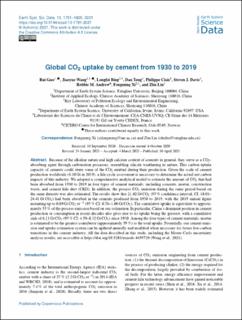| dc.description.abstract | Because of the alkaline nature and high calcium content of cements in general, they serve as a CO2- absorbing agent through carbonation processes, resembling silicate weathering in nature. This carbon uptake capacity of cements could abate some of the CO2 emitted during their production. Given the scale of cement production worldwide (4.10 Gt in 2019), a life-cycle assessment is necessary to determine the actual net carbon impacts of this industry. We adopted a comprehensive analytical model to estimate the amount of CO2 that had been absorbed from 1930 to 2019 in four types of cement materials, including concrete, mortar, construction waste, and cement kiln dust (CKD). In addition, the process CO2 emission during the same period based on the same datasets was also estimated. The results show that 21.02 Gt CO2 (95 % confidence interval, CI: 18.01– 24.41 Gt CO2) had been absorbed in the cements produced from 1930 to 2019, with the 2019 annual figure mounting up to 0.89 Gt CO2 yr−1 (95 % CI: 0.76–1.06 Gt CO2). The cumulative uptake is equivalent to approximately 55 % of the process emission based on our estimation. In particular, China’s dominant position in cement production or consumption in recent decades also gives rise to its uptake being the greatest, with a cumulative sink of 6.21 Gt CO2 (95 % CI: 4.59–8.32 Gt CO2) since 1930. Among the four types of cement materials, mortar is estimated to be the greatest contributor (approximately 59 %) to the total uptake. Potentially, our cement emission and uptake estimation system can be updated annually and modified when necessary for future low-carbon transitions in the cement industry. All the data described in this study, including the Monte Carlo uncertainty analysis results, are accessible at https://doi.org/10.5281/zenodo.4459729 (Wang et al., 2021). | en_US |

